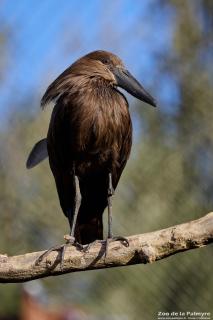Hamerkop

Hamerkop

-
Class
Aves -
Order
Pelecaniformes -
Familly
Scopidae
-
 50-56 cm
50-56 cm -
 415-430 g
415-430 g -
 28-30 days
28-30 days -
 3-7
3-7 -
 20 years
20 years
-
Diet
carnivorous (amphibiens, small fish, crustaceans, insects, worms) -
Habitat
wooded wetlands -
Range
Sub-Saharan Africa & Madagascar -
Population in the wild
Unknown
The Hamerkop is a medium-sized wading bird with sepia brown plumage with a slight iridescent purplish gloss on the back. Its name Hamerkop means « Hammer-head » in Afrikaans: from side-on, the shape of its head with its long thick bill and backward-pointing crest is reminiscent of a hammer or anvil.
Being the only species in the genus Scopus, itw as long considered part of the Ciconiiformes before being classified among the Pelecaniformes. Some of the hamerkop’s unique habits and behaviors, as well as its physical similarities to several bird families (pectinated middle toe as in the herons, free hind toe as in the flamingos, egg-white protein like the storks, ectoparasites comparable to those of plovers), have led texonomists to place it in its own monospecific family: Scopidae. DNA analyses suggest it should be placed between herons and flamingos, not far from storks and shoebills, its traditional allies.
The hamerkop is carnivorous and eats primarily amphibians and small fish, sometimes supplemented with crustaceans, insects, worms and occasionnally small mammals. It feeds mainly in shallow water due to its relatively short legs and neck. Wading accross aquatic vegetation, it probes the mud for its prey. Remarkably, it is also able to catch prey from the water while in flight thanks to its low wing-loading.
Sedentary and territorial, it generally lives alone, in pairs or in small groups of about 10 individuals. Groups of 50 birds can sometimes be observed. Active during the day and at dusk, it rests in shady trees during the hottest hours of the day.
The hamerkop builds a very complicated and imposing dome-shaped nest comparing to its size. Made of thousands of twigs clumped together and sealed with mud and grass, it is placed in a large tree and can reach 1.5m in height and width. Nest-building is carried out by both adults and can last 3 to 6 weeks. The Hamerkop is a compulsive nest builder: it can construct 3 to 5 nests in its territory. It doesn’t necessary use them, some are even never completed. The reason why the species spends so much energy building multiple nests is remains unclear, but the fact that their construction isn’t necessarily correlated with breeding suggests that this may help strengthen the bond between the male and the female.
A narrow opening at the base of the nest, extended by a tunnel about sixty centimeters long provides access to an inner nesting chamber about 40cm wide and 60cm high. This complicates access from predators burt monitor lizard and snakes remain serious threats for the chicks. Barn Owls and Verreaux’s Eagle Owl sometimes take over the hamerkop’s nest while they’re being built, while small birds like sparrows like to build their own nests in.
The female can lay up to seven eggs which are incubated alternatively by both parents for about 30 days. Chicks are covered with grey down which is quickyl replaced by feathers. Their crest begins to develop after six days and by the age of one month, their plumage is almost identical to that of the adults. Fed by both parents, they leave the nest at around 47 days old but often return to roost there for about a month after fledging.
The hamerkop is associated with many beliefs and superstitions. In African mythology, anyone who attacks a hemerkop’s nest will be struck by lightning, hence its name « lightning bird ». Its reputation as a « magical » bird is perhaps also due to its impressive nest made of twigs but also bits of bone, skin or human rubbish and from sometimes emerge a multitude of different species such as snakes, bees, genets or monitor lizards. The fear and respect it inspires thus protects it from human persecution.






